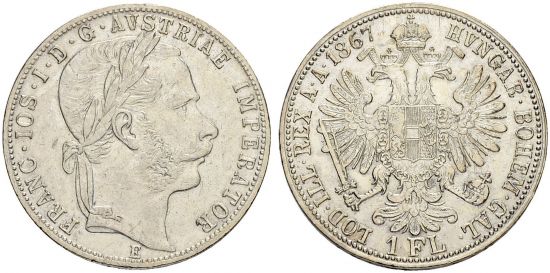Austria 1867-E florin
This specimen was lot 2757 in Sincona sale 43 (Zürich, October 2017), where it sold for 4,000 CHF (about US$4,773 including buyer's fees). The catalog description[1] noted,
"Franz Joseph I. 1848-1916 Gulden 1867 E. Karlsburg. Von grösster Seltenheit. Sehr schön. (empire of Austria, Francis Joseph I, 1848-1916, gulden of 1867, Karlsburg mint. Of the highest rarity, Very fine.)"
The florin, about the size of a half dollar, was introduced in Austria in 1857 in a feeble attempt to decimalize the currency. It was accompanied by a quarter florin and a double florin and the half thaler was dropped. The mélange of billon small change was reorganized into twenty, ten, five, one and 5/10 kreuzer. This system obtained, tho the thaler and ducat continued, until another reform introduced the corona in 1892. This type was struck 1867-72 at Vienna (A), Kremnitz (B) and Karlsburg (E, shown here); this is a rare date.
Recorded mintage: 155,147.
Specification: 12.34 g, 0.900 fine silver, 29 mm diameter, this specimen 12.32 g.
Catalog reference: KM 2221, Herinek 30, Veselý 66, Jaeckel 335 a.
- Herinek, Gerhard, Austria Münzkatalog: Munzen ab 1745 und Banknoten ab 1759, 49. Auflage, Vienna: Christine Steyrer Verlag, 2022.
- Michael, Thomas, and Tracy L. Schmidt, Standard Catalog of World Coins, 1801-1900, 9th ed., Iola, WI: Krause Publications, 2019.
- Veselý, Roman, Mince a medaile, 19. století, František II ab Karel I, Prague: Aurea Numismatika, 2020.
- [1]Richter, Jürg, Auction 43: Gold and Silver Coins and Medals, Zürich: Sincona AG, 2017.
Link to:
